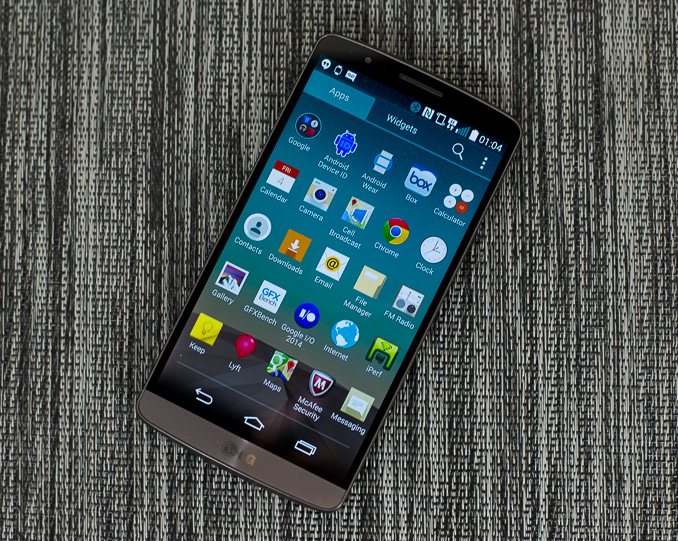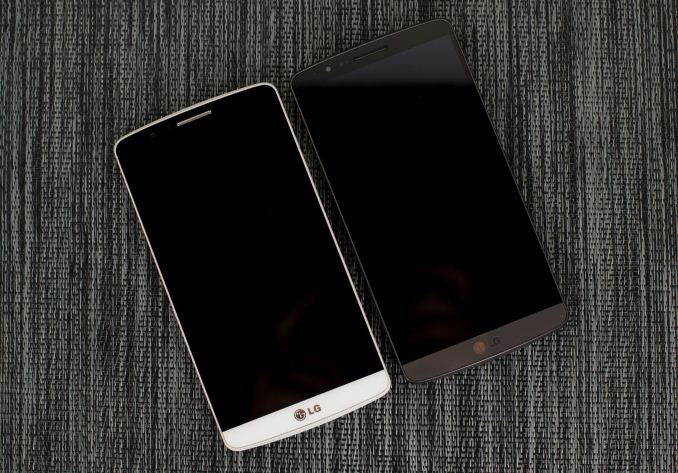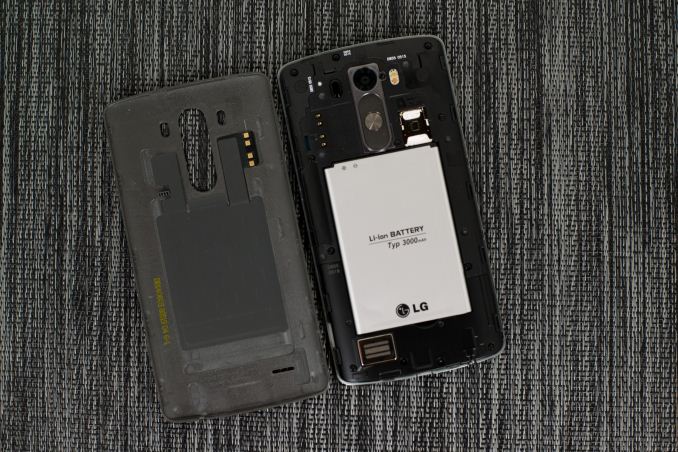The LG G3 Review
by Joshua Ho & Anand Lal Shimpi on July 4, 2014 5:00 AM EST- Posted in
- Smartphones
- LG
- Mobile
- Laptops
- G3

While the enthusiast segment is no stranger to LG smartphones, for the most part LG hasn’t received nearly the amount of attention that Samsung has. At first, it doesn’t make much sense. After all, LG is almost as big as Samsung. Both are chaebols, with enormous resources and power that few other companies have. Starting from the Optimus G, it seems that LG has shipped some of the best hardware in the industry, leveraging all the branches of the company from LG Innotek to LG Display to make a product that was easily equal to or better than the competition at the time.
One of the real issues that LG faced was a credibility gap. After the Optimus 2X and 4X HD, LG simply lacked credibility amongst the enthusiast audience. Without this audience and without the marketing push that other OEMs had, LG phones simply didn’t sell. Fortunately, things have gotten better since those days. The G2 brought significant attention to LG phones, and if anything, LG has been the sleeping giant in the industry. LG’s displays have been some of the best in the industry, and as an Android OEM they’ve consistently executed well on hardware. The immense popularity of the LG-made Nexus 4 and 5, even amongst mainstream consumers is surprising, especially because they were supposed to be developer devices.
Hardware
This leads us to the LG G3, which is now available in Korea and ready to be sold internationally. LG now faces the difficult task of succeeding the G2, one of the best phones of 2013. To find out whether they’ve made a worthy successor, we start with industrial and material design. When you first pick up the G3, it’s obvious that LG wanted to make a phone with the look and feel of brushed aluminum. To this end, LG has definitely done a good job. Although the polycarbonate back feels much warmer in the hand, the texture is good, and in practice even after extended use I never felt like the phone was grimy. It’s good to see that most of these OEMs are moving away from glossy finishes. The back cover is also removable, which allows for a removable battery and microSD slot. The front of the display is almost unchanged from last year, with extremely small bezels all around to reduce wasted space. The one change to the front of the phone is a band of color around the bottom that matches the color of the back.
Around the sides, the port layout remains nearly identical. The top has the IR Tx/Rx ports, the bottom has the 3.5mm jack and a microUSB port in the USB 2.0 shape. LG has also added a beveled edge from the display to the sides, which emphasizes the curved nature of the back. On the back of the phone, one can see the camera with the IR rangefinder and LED flash to the sides. The volume and power buttons are directly below the camera. The volume rocker is relatively flat compared to the protruding power button, which also has a noticeably different texture to distinguish the two from each other. The single, 1W speaker is towards the bottom.
Outside of these basic button and port placements, the hardware itself is high-end. The key differentiation points in this case are the camera system, QHD display, and the high-power speaker. I’ve put the rest of the basic specs in the table below.
| LG G3 | |
| SoC | MSM8974AC 2.45 GHz Snapdragon 801 |
| RAM/NAND | 3 GB LPDDR3, 32GB NAND + microSD |
| Display | 5.5” 1440p IPS LCD |
| Network | 2G / 3G / 4G LTE (Qualcomm MDM9x25 UE Category 4 LTE) |
| Dimensions | 146.3 x 74.6 x 8.9mm, 149 grams |
| Camera | 13MP rear camera, 1.12 µm pixels, 1/3.06" CMOS size, F/2.4. 2.1MP F/2.0 FFC |
| Battery | 3000 mAh (11.4 Whr) |
| OS | Android 4.4.2 with LG UI |
| Connectivity | 802.11a/b/g/n/ac + BT 4.0, USB2.0, GPS/GNSS, MHL, DLNA, NFC |
| SIM Size | MicroSIM |
While the spec sheet gives an idea of what to expect from the G3’s size, it’s surprisingly small for a 5.5” display size device. Unfortunately, this doesn’t make the G3 easy to use with one hand. While using the One (M8) and Galaxy S5 with one hand is uncomfortable, the G3 is almost impossible to use with one hand. Trying to tap something on the left side of the phone when using it with the right hand is difficult, and trying to reach for something on the top left of the display is almost impossible. While the division between phone and phablet is relatively clear in my mind, the G3 is in the line between both. I don’t object to the phablet formfactor, but this is supposed to be a phone, not a phablet. In addition, because the G3 has such thin bezels, it's very easy to accidentally activate the touch panel unintentionally while trying to stretch for one area of the display.
Other than the size, I definitely like what LG has done here. The design of the phone is understated and classy, even if it’s a bit off-putting that LG is trying to make plastic feel like metal. The back buttons are a non-issue, even without KnockOn/Off and KnockCode, and the curved back is great for ergonomics. However, I question the wisdom of moving to a removable battery/back cover in this case, as it means that there’s no stacked battery that we saw in the LG G2 and reduces volumetric efficiency. LG has included a curved battery in the G3, although in practice the curve isn't as aggressive as the one we've seen on the G2.













174 Comments
View All Comments
piroroadkill - Friday, July 4, 2014 - link
Basically, the screen is stupid, costs more, wastes battery, slows down performance, heats it up so it throttles more, and isn't actually noticeably different compared to 1920×1080 at viewing distance.Yeah, so predictable. LG is doing the worst kind of spec-sheet oneupmanship.
Homeles - Friday, July 4, 2014 - link
I picked up a G2 last year, and was a bit frustrated that the G3 came out so quickly. Looks like I'm not missing out.piroroadkill - Friday, July 4, 2014 - link
Yeah, the G2 is a fine device, and I'd choose the better battery life.mahalie - Friday, July 4, 2014 - link
The G3 has significantly better battery life than the G2. You can complain that the screen is unnecessary all you want, but the phone performs wells and has great battery life, so what's the issue?fokka - Friday, July 4, 2014 - link
the g3 beat the g2 in one test here, what numbers are you referring to?the issue, as i see it, is that the 1440p display adds cost, decreases performance, battery life and screen brightness, not to mention overall screen quality, compared to using a good 1080p display, all while adding very little in regards to usability and visual advantages.
many people, me included, think that LG should have gone with a "good ol'" 1080p display in this generation and improved upon the great battery life that the g2 offered, instead of using a 1440p screen with borderline useful benefits mainly for bragging rights.
of course not everybody agrees with this stance, but it seems to be the one main complaint about this otherwise mighty fine piece of technology.
and you are right, the g3 (still) performs well and (still) has great battery life, but with a more reasonable 1080p display those points could have improved even more. that's all i (!) am saying.
retrospooty - Friday, July 4, 2014 - link
You may be right about the screen. Looks like some trade-offs were made, but it's still a good phone that stacks up well against it's competitors. It's still a good 5.5 inch phone that is basically the same size as an S5 or One M8. That and I cant remember the last time I had any phone on 100% brightness. I have a G2 now and keep it as 66%. In rare cases I move it up to 70%. 75% is simply too bright to look at.flatrock - Tuesday, July 8, 2014 - link
I just checked the brightness on my G2. It's at 41% and is plenty bright for indoor viewing at that level. I might put it up to 75% while using it outdoors such as at my son's soccer game. Unless the sun is shining directly on the screen, 100% is overkill. In a dark rooms I set the brightness somewhere in the teens.ColinByers - Monday, September 29, 2014 - link
Well, LG G3 is definitely one of the better phones on the market, all though there are a few like HTC One M8 and Motorola Moto G that can compete with it (see http://www.consumertop.com/best-phone-guide/ for example).upatnite2 - Friday, July 4, 2014 - link
Same thoughts! I can deal with the battery life, but brightness and contrast are major issues. We're seeing at least a few reviews that mention "dim", which isn't a good sign, and I'm starting to wonder about performance after it heats.If they put in the same display as last year, LG would sell tons more, and myself included.
Now, I have to wait to see if the S805 vsn comes to the states and if it's any better, wait for the N6, or get a used G2..
HotInEER - Monday, July 7, 2014 - link
I agree. 3 things are keeping me from trading in my HTC One M8 for this. The brightness, contrast, and lack of built in wireless charging. I don't want a flip case for that feature. Can't stand them, and sure in the heck are not paying $60 for a stupid case for that. I'd consider buying a additional back for wireless charging, however I've read on numerous sites that the US models do not have the pins.